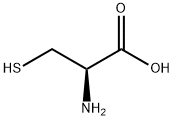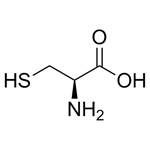1. L-Cysteine is one of the 20 natural amino acids and, besides methionine,the only one which contains sulfur.
2. L-Cysteine is a thiol-containing non-essential amino acid that is oxidized to form CYSTINE.
3. Cysteine is a non-essential sulfur-containing amino acid in humans, related to cystine, Cysteine is important for protein synthesis, detoxification, and diverse metabolic functions. Found in beta-keratin, the main protein in nails, skin, and hair, Cysteine is important in collagen production, as well as skin elasticity and texture. Also required in the manufacture of amino acid taurine, Cysteine is a component of the antioxidant glutathione, and plays a role in the metabolism of essential biochemicals such as coenzyme A, heparin, and biotin. (NCI Thesaurus (NCIt))
4. L-Cysteine is used as a precursor in food, pharmaceutical and personal care products. It is actively involved in the production of flavors such as meat flavor obtained by reacting with sugars. Also used for the cleavage of disulfide bonds in the hair's keratin. It plays an important role as a key raw material for the manufacture of N-acetyl-L-cysteine, S-carboxymethyl-L-cysteine and L-cysteine base. Its derivative, N-acetyl-L-cysteine is used as a dietary supplement. It acts as an antidote to acetaminophen overdose and prevents liver failure. It protects nerves from oxidation and thereby prevents illnesses like Alzheimer's and Parkinson's. Being an essential amino acid, it used as animal feed especially for sheep, which is responsible the growth of wool.(Alfa Aesar)
5. L-cysteine is an amino acid that is classified as semi-essential in humans, meaning that the body biosynthesizes adequate amounts of it under normal circumstances. The biosynthesis of l-cysteine requires methionine, which supplies the sulfur needed to make this amino acid. This requirement is one of the primary reasons that sulfur is an essential human nutrient.
6. L-cysteine is available through many dietary sources, primarily animal protein. Eggs and dairy products also contain significant levels of l-cysteine. Vegetable sources of l-cysteine include broccoli, Brussels sprouts, garlic, granola, sprouted lentils, oats, onions and peppers. The commercial extraction of l-cysteine typically uses human hair, due to its high concentration of this amino acid. Other commercial sources include hog hair and poultry feathers. L-cysteine may also be synthesized in a process that involves fermentation by a variety of E. coli.
7. L-Cysteine’s high reactivity makes it essential in many biochemical reactions. This amino acid is a thiol, meaning that it has a sulfhydryl group at one end of its chain. This group consists of a sulfur and hydrogen atom, and is the primary reason that l-cysteine is chemically active. In particular, l-cysteine readily undergoes reduction-oxidation reactions, commonly known as redox reactions. This reactivity gives l-cysteine strong antioxidant properties, which help support cells from different types of damage.(xtend-life)



